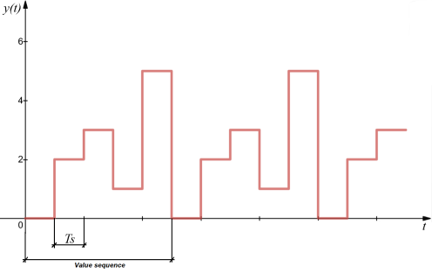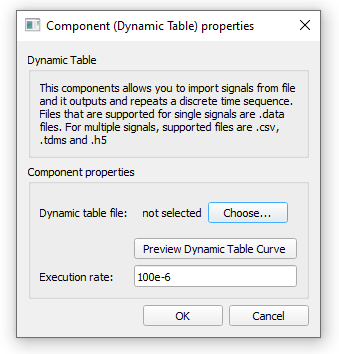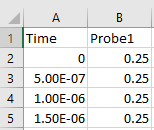Dynamic Table
Description of the Dynamic Table component in Schematic editor, which outputs and repeats a custom value sequence imported from a file.
Component icon

Description
The Dynamic Table component outputs and repeats a custom value sequence which is imported from a file.
The value sequence is defined as a list of values. The component outputs a number from the list every simulation step. Once it reaches the end of the list, it starts from the beginning.
For the value sequence [0, 2, 3, 1, 5], the output would look like Figure 2.


Ports
- Output (out)
- Repeating sequence waveform output by the component.
- Supported types: uint, int, and real.
- Vector support: no.
- Repeating sequence waveform output by the component.
Properties


- Dynamic table file
- Import file with the sequence of values that will be generated. Files that are supported are .data, .csv, .tdms, and .h5.
- For .csv, .tdms, and .h5 files, the first column should be named "Time" and each other column should be named matching a signal we want to reproduce.
- When using .data files, only single signals are supported. With all other file extensions, multiple signals are supported.
- File size limitations:
- The Dynamic Table component can only import files with up to 5 million data points. The number of data points is calculated as: number of signals * time points in the "Time column".
- For real-time/VHIL simulation, the number of data points in a file should remain under 3 million to ensure compiling.
- Execution rate
- Type in the desired signal processing execution rate. This value
must be compatible with other signal processing components of the same circuit: the value must
be a multiple of the fastest execution rate in the circuit. There can be up to four different
execution rates. To specify the execution rate, you can use either decimal (e.g. 0.001) or
exponential values (e.g. 1e-3) in seconds. Alternatively, you can type in ‘inherit’ in which
case the component will be assigned execution rate based on the execution rate of the components
it is receiving input from.
For .csv, .tdms and .h5 files,execution rate will be set based on “Time” column of imported file.
- Type in the desired signal processing execution rate. This value
must be compatible with other signal processing components of the same circuit: the value must
be a multiple of the fastest execution rate in the circuit. There can be up to four different
execution rates. To specify the execution rate, you can use either decimal (e.g. 0.001) or
exponential values (e.g. 1e-3) in seconds. Alternatively, you can type in ‘inherit’ in which
case the component will be assigned execution rate based on the execution rate of the components
it is receiving input from.
- Preview dynamic table curve
- This button will graph the value sequence list.